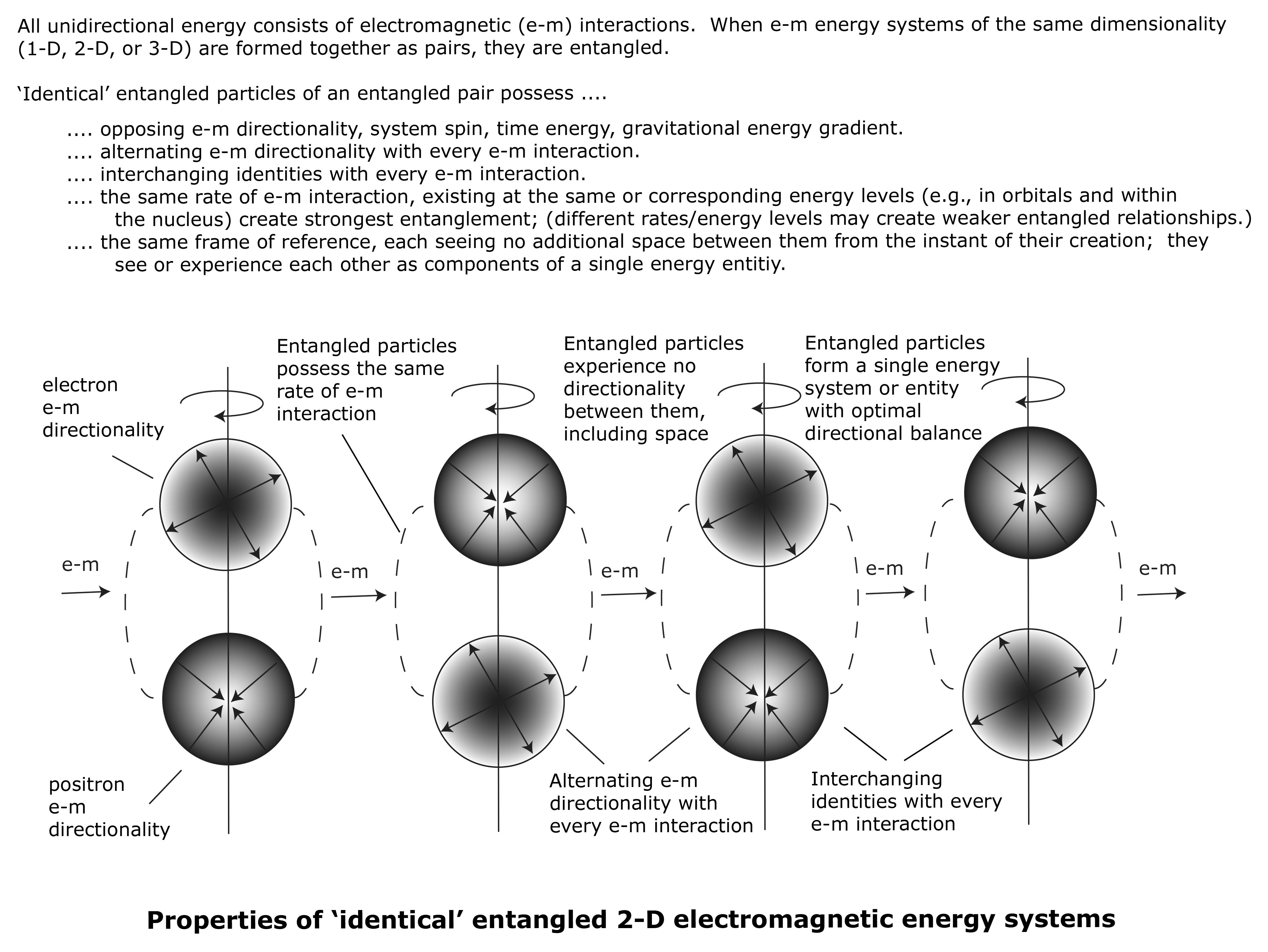 An entangled 2-D positron/electron particle and its 2-D electron/positron partner represent identical particles with opposing directionality with every electromagnetic (e-m) interaction. The 2-D positron/electron is designated by e+- and the 2-D electron/positron is designated by e-+ to show that each of the entangled particles alternates e-m directionality with every e-m interaction. In other words, with each e-m interaction, an electron becomes a positron and its entangled positron partner becomes an electron. With the next e-m interaction, the positron becomes an electron and the electron partner becomes a positron. And the process keeps repeating itself, alternating e-m directionality with every e-m interaction.
An entangled 2-D positron/electron particle and its 2-D electron/positron partner represent identical particles with opposing directionality with every electromagnetic (e-m) interaction. The 2-D positron/electron is designated by e+- and the 2-D electron/positron is designated by e-+ to show that each of the entangled particles alternates e-m directionality with every e-m interaction. In other words, with each e-m interaction, an electron becomes a positron and its entangled positron partner becomes an electron. With the next e-m interaction, the positron becomes an electron and the electron partner becomes a positron. And the process keeps repeating itself, alternating e-m directionality with every e-m interaction.
Entangled identical 2-D particles possess simultaneously alternating e-m directionality and interchanging identities with every e-m interaction – this represents the strongest type of entanglement.
The ‘identical’ entangled 2-D partners compose a single energy entity with optimal directional balance. Each entangled partner could be thought of as an opposing pole of a single particle. The 2-D e-m directionality of the electron is outward from system center while the 2-D e-m directionality of the positron is inward to system center.
The electron 2-D electric energy moves outward from a strong gravitational energy gradient (i.e., high ratio of potential:kinetic energy of space) to a weaker gravitational energy gradient (i.e., lower ratio of potential:kinetic energy of space) resulting in a negative charge field. The positron 2-D electric energy moves inward from a weaker gravitational energy gradient (i.e., low ratio of potential:kinetic energy of space) to a stronger gravitational energy gradient at system center (i.e., higher ratio of potential:kinetic energy of space) resulting in a positive charge field. The two entangled particles directionally balance both the gravitational gradients and the resulting negative and positive charges. So these properties along with other quantum properties of the entangled 2-D partners are directionally balanced due to alternating e-m directionality and interchanging identities with every e-m interaction.
The inherent energy of space forms magnetic energy to provide directional balance to unidirectional electric energy in an e-m interaction. But the energy of space must also form time energy to provide directional balance to the formation of the magnetic energy. Time energy forms at 180 degrees to the magnetic energy, but immediately dissipates as it forms to allow its ‘sister’ magnetic energy to provide maximum directional balance to the electric energy.
Time energy forms in opposite directions for an electron versus a positron. So in the case of an entangled electron/positron pair, time energy, like all other quantum properties, is directional balanced. If time energy is cancelled, or neutralized, then what does than mean for ‘distance’ between the two entangled partners? Time does not have net directionality between the two partners. So how does that affect ‘distance’ between the two entangled particles?
(No answer here – only a question that leads to more questions. When an elementary energy system is directionally balanced, with all quantum properties neutralized, then each pair of e-m interactions appear to not really happen. Yet, for each particle, every e-m interaction is just as real as if it was not entangled with a partner. So for the entangled energy system, quantum properties are directionally balanced, or ‘nonexistent’ from an observer’s point of view. But for each component particle of the entangled energy system, all of its quantum properties are ‘real.’)
Unlike isolated, unentangled electrons or positrons, the 2-D electric energy does not need to recycle to its highest energy level as 1-D electric energy along a 1-D axis of spin. Instead, the 2-D electric energy of the entangled e-+ and e+- particles simply moves outward from or inward to system center with every e-m interaction since the entangled particles together form a single energy entity with optimal directional balance.
